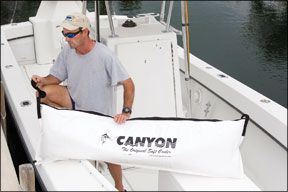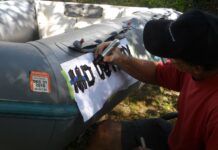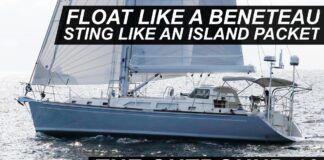If you like trolling while you sail, and youre good at it, youll inevitably land some fish too big for the cooler or ice box. Heres a powerboat-oriented product that might save you the trouble of spilling blood, and guts on your nice clean deck, just 288 so you can put that oversized striper, wahoo, or mahi on ice. Enter insulated fish bags. We looked at three bags capable of holding a fish weighing 50 pounds, plus ice. Since getting three fish exactly the same size would have been nearly impossible, we elected to use only ice to test the bags. We placed 50 pounds in each one, then threw them on the deck of our test boat. After they sat for 10 hours in both sunlight and shade, we opened each bag and found lots of solid ice remaining. The daytime outside temperature was 80 degrees. We let the bags sit on the deck overnight, inspecting them again the following morning. This time we removed the remaining ice in each bag and weighed it. We also considered construction, design, and price. Canyon
This 20×64-inch bag is constructed with heavy-duty, fiber-interlaced PVC skins with closed-cell foam sandwiched between two layers for insulation. The bottom and both sides are heat-sealed to supply a leak-proof seam. A smooth-operating zipper closes the top of the bag. The zipper pull is metal, not our material of choice on any piece of marine gear. Handles made from 2-inch-wide nylon webbing are attached at each end. One bottom corner has a drain. A stretch strap with Velcro-like fasteners holds the bag in a rolled-up position for storage. The Canyon bag performed best in our test, with 30 pounds of ice remaining after 20 hours. Canyon makes a dozen different sizes. This one is $135.
Bottom Line:
Our top pick. It performed better than the others, doesn’t leak, and it is well constructed.CE Smith
The biggest of the three bags tested, this one measures 22×66 inches. The outside layer is white heavy-duty, marine-
grade vinyl. A reflective inner liner is sewn to the outer layer with a half-inch of closed-cell foam between the two. A heavy-duty, two-pull nylon zipper (ours was a little stiff at the corners) extends around both sides and the top to make getting fish and ice in and out easier. Four handles are sewn to the top. It has sewn-on storage straps and a nylon carry bag for easy stowage. This bag had only 15 pounds of ice left after 20 hours. It is $130.Bottom
Line: A big bag that takes up little stowage space. It did not hold ice as well as the others.Offshore Angler
At 17x 57 inches, this is the smallest bag in our test. Its made from two layers of fiber-interlaced plastic with a layer of foam insulation between. The side seams are sewn together with nylon webbing. The top closes with a two-pull zipper, which operated well, but the metal zipper-pull could suffer from saltwater exposure over time. Handles are 2-inch-wide nylon webbing sewn all the way around the bag. There is no accompanying storage strap, and the provided storage bag is made from thin, clear vinyl. In our opinion, the storage bag wont last on most boats. In the ice test, this bag performed well, with 25 pounds of ice remaining. Several sizes are available; this one is $80.
Bottom
Line: A good performer, and its $50 less than the Canyon. Its our Budget BuyConclusion
The usefulness of a fish-storage bag depends on how much you fish for that big catch and how little you like gutting it underway. If youre short on refrigerated storage space and big on fishing, then we suggest the Canyon bag. It has heat-sealed edges and
did the best in our ice-retention test. Its our top pick.






































